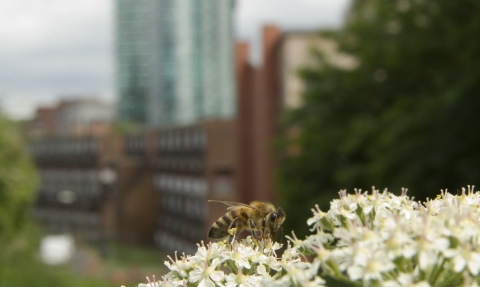
Wildflowers © Gillian Day
Planning
Development is one of the most significant pressures facing wildlife in Hertfordshire and Middlesex.
The Trust is involved in the planning process for the purpose of securing biodiversity gain and preventing negative impacts of development on biodiversity. The Trust is engaged with planning at both a strategic level (commenting on Local Plans and Neighbourhood Plans) and at the Development Management stage. The Trust is neutral to development and considers each development on its own merits and assesses its potential impact purely on biodiversity issues. In providing responses to planning applications and strategic planning documents, the Trust will provide information based on available evidence, sound science and without bias.

Wildlife in urban landscape (c) Paul Hobson
Advice on responding to planning consultations
We encourage local residents to participate in consultations on Local Plans.
We prioritise staff time by working on those cases where there will be the most significant positive or negative effects on wildlife. There are many other planning applications coming forward though, where local residents can play a role.
Keep an eye open for consultation announcements on your district council’s website and in the local press. Local Plan consultations are generally open for six weeks. Make sure you read through the consultation documents and background information when considering your reply, and submit your comments in the format requested by your local council.
Where possible, try to draw on policy in the National Planning Policy Framework and other relevant government policies, guidance and legislation, in order to justify any objections.
At the end of the day, though, consultations are for the public and the council officers will not expect you to be experts in planning. They should be able to interpret your objections and comments in planning terms. Make sure to include where relevant any knowledge you have on your local area, including its wildlife interest. Council officers may not be aware of it.
Ten tips for responding to planning applications
- Make sure to read through the plans and documents, so that you have a clear view of what the development entails and what the impacts may be. Plans and documents are made available for public viewing on your district/borough council’s website. You can contact the case officer for the application if you would like more information.
- Consider what impacts the proposed development may have on wildlife. Read through any ecological surveys that have been submitted with the application, and refer to them in your comment. If no surveys have been done, but you think they should have been, state this in your comment. You may like to make reference to Natural England's Standing Advice on protected species. Please see our section on development and wildlife for more information.
- Follow your council’s instructions for submitting comments. Normally you can submit your comments online through your council’s planning portal, or by email or letter to the case officer or to the planning department. Make sure to include the application reference number in the subject line or heading.
- Make your letter concise, and communicate your concerns clearly.
- Present your concerns in a formal, polite and effective manner.
- Clearly relate and ground your comments in Local Plan policy, national planning policy or other legislation. Case officers will only consider matters that are ‘material considerations’ in the planning system, which basically means they must be covered by legislation or planning policy. Please refer to our section on planning policy.
- Where relevant, remind the local authority of wildlife legislation, national biodiversity policy and the Hertfordshire Biodiversity Action Plan.
- Be realistic and constructive in your comments, for instance suggesting alternative locations or design solutions that would overcome your concerns.
- Keep in mind that the local authority may decide that overall the benefits of a proposal outweigh any possible harm. Consider and suggest to the case officer how the wildlife issues may be effectively mitigated or compensated for. Recommend to the case officer that conditions are applied to ensure sufficient and suitable biodiversity mitigation and enhancement if the development is granted permission.
- Remember, your view is important and the local authority has a duty to listen.

Planning policy
Local authorities make decisions about development on the basis of planning policy.
Local Plans
District and borough councils develop and use Local Plans to make decisions about planning. These plans are designed to allow councils to ensure that development contributes towards their area’s specific needs, priorities and objectives. Any development proposals must comply with policies set out in each council's Local Plan.
With the introduction of new national planning policy (the National Planning Policy Framework) in 2011 which saw the old system of Local Development Frameworks scrapped (see recent changes below), most local authorities in Hertfordshire are still working on their Local Plans. Further public consultation rounds are expected. You can check the progress that has been made by your district or borough council through their website.
The following local authorities have produced core strategies for their Local Plans:
Recent changes in planning policy
The Planning and Compulsory Purchase Act 2004 required local authorities to compile a ‘Local Development Framework’ (LDF) for their area, to replace previous district local plans. Relatively few local authorities had yet adopted a Local Development Framework when the government's new planning framework, the National Planning Policy Framework (NPPF), was published in March 2011. A copy of the NPPF is available here. This new framework replaced the preceding suite of planning policy statements and guidance notes, and responded to the government’s wish to simplify the planning system.
The NPPF again altered the requirements on local authorities, and reverted to the terminology of ‘local plan’. As part of the government’s wider reforms of the planning system, the Localism Act 2010 abolished Regional Spatial Strategies and the associated housing targets, transferring powers to local authorities, and introduced the concept of neighbourhood planning, to which local authorities need to respond in their Local Plans.
Planning decisions in local authorities without an up-to-date Local Plan are made based on existing policies (‘saved policies’ from previous district local plans) and the National Planning Policy Framework.
Neighbourhood Plans
The Localism Act grants powers to parish councils and neighbourhood forums in unparished areas to put together a Neighbourhood Plan for their parish or neighbourhood. Neighbourhood plans must conform with Local Plans and the NPPF.
Neighbourhood Plans are able to propose more development, but cannot reduce the amount of development in the area from that agreed in the Local Plan.
Neighbourhood Plans can however guide where this development is located and how it is achieved. They can give parishes and neighbourhood forums the power to form and shape development. For instance, a Neighbourhood Plan may require a higher proportion of affordable housing, or enable development to be directed to less valued sites instead of important wildlife sites or community land.
Government planning policy and guidance
The government's policy on planning is set out in the National Planning Policy Framework. It includes policies on conserving and enhancing the natural environment.
National planning policy is supported by planning guidance, which explains further and gives clarity to planning policy, helping local planning authorities and developers to interpret policy and understand government and legal requirements. The government Planning Practice Guidance can be accessed alongside the National Planning Policy Framework here. The guidance includes a section on the Natural Environment, as well as guidance on Environmental Impact Assessment, light pollution, climate change and open space which may have relevance to wildlife interests.
Harpenden Common (c) Tim Hill
Development and wildlife
When planned and delivered well, development can have a positive impact for wildlife.
Developers need to identify the potential impact of their proposed development on local wildlife and make sure that measures are taken to avoid, mitigate and as a last resort, compensate for any detrimental effects. This is known as the mitigation hierarchy.
Getting a survey done
Where there is a reasonable risk of harm to wildlife, developers should commission an ecological survey of the site and its buildings, to identify likely impacts and inform mitigation. The results from surveys should feed into the design planning of developments.
It is imperative that suitable ecological surveys are undertaken where there is a chance that a development may impact upon wildlife, including protected and priority habitats and species. Where there is a reasonable likelihood of harm but the required surveys have not been done, then planning applications should be refused.
Incorporating measures for wildlife
Negative ecological impacts can be avoided and mitigated through choosing a considerate location and layout, modifying the design of the development, and using landscaping positively to protect and enhance what wildlife and habitat is already there.
A net gain for biodiversity can be delivered through creating wildlife-friendly landscaping, incorporating spaces for wildlife in buildings and within the development, and looking to improve ecological connectivity, for instance.
Developments can impact on wildlife and ecological networks in various ways, both during construction and operation of the development. Impacts may be temporary or permanent.
Issues to consider
Loss or damage of important wildlife habitat
Important wildlife habitats include statutory nature conservation sites, Local Wildlife Sites, Biodiversity Action Plan (BAP) priority habitats, or habitat that is important in providing an ecological link.
The NPPF says that development must deliver no net loss and where possible net gain to biodiversity - not just priority habitats and species. Therefore HMWT request local planning authorities to ensure that all development, when requested, undertake a biodiversity impact calculation assessment by utilising the Biodiversity Impact Calculator. This mechanism (based on the DEFRA biodiversity assessment metric) ensures an objective, measurable, transparent and repeatable assessment is provided to enable the LPA to properly determine if no net loss or net gain to biodiversity has been achieved. This assessment primarily applies to non-priority habitats.
Indirect impacts on important habitats
Through pollution, air quality changes, artificial lighting, noise disturbance, increased recreational pressure, etc.
Potential risks to protected or priority species
For instance through:
- loss or damage of breeding sites or resting places;
- loss or damage of foraging habitat;
- loss of habitat connectivity;
- injury or killing of individual animals during construction, etc.
Statutory nature conservation sites include:
Sites of Special Scientific Interest (SSSIs), Special Protection Areas (SPAs), Special Areas of Conservation (SACs) and Ramsar sites (wetland sites of international significance).
Priority habitats means:
NERC Act Section 41 habitats of principle conservation importance and national and local Biodiversity Action Plan priority habitats.
Protected species include:
European Protected Species (including bats, otters, dormice, great crested newts) and species protected by domestic legislation (including reptiles, water voles, badgers, nesting birds). Further information is available from the Joint Nature Conservation Committee, which advises government.
Priority species means:
NERC Act Section 41 species of principle conservation importance and national and local Biodiversity Action Plan priority species.
Advice on protected species
Natural England has issued advice on protected species, which local planning authorities should consider when making planning decisions. This advice helps case officers to decide whether there is a reasonable likelihood of protected species being present, and provides advice on survey and mitigation requirements. The standing advice is a useful resource for case officers, for planning applicants when considering a development and also for local people concerned about developments in their area that may affect wildlife.
View down to the Broadwater at Panshanger Park (c) Jen Gilbert
Wildlife and the law
For information on important legislation in the UK relating to wildlife and the natural environment, we recommend you visit the websites of the Joint Nature Conservation Committee.
The following are the key pieces of legislation relevant to planning and development decision making.
England and Wales
Conservation of Habitats and Species Regulations 2017
Conservation of Habitats and Species (Amendment) Regulations 2012
Transpose into UK law provisions of the EU Habitats and Wild Birds Directives, including in relation to designation and protection of Special Areas of Conservation and Special Protection Areas (‘Natura 2000’ protected sites of European importance), setting out the legal protection for certain species of animal and plant, and also establishing the system for assessment of plans or projects affecting European protected sites.
Wildlife and Countryside Act 1981 (as amended)
Part 1 establishes legal protection for all wild birds in the UK, and stronger protection for birds listed in Schedule 1 of the Act. Part 1 also sets out legal protection for wild animals listed in Schedule 5 and wild plants listed in Schedule 8 of the WCA.
Other parts of the Act amend legislation relating to nature conservation, for instance in respect of the designation, protection and management of SSSIs; roles, responsibilities and requirements in respect of National Nature Reserves and Ramsar Sites; and policy on National Parks and public rights of way.
The Natural Environment and Rural Communities Act 2006 (‘NERC Act’)
Section 40(1) places a direct statutory duty on all public authorities to conserve biodiversity:
Every public authority must, in exercising its functions, have regard, so far as is consistent with the proper exercise of those functions, to the purpose of conserving biodiversity.
Section 40(3) clarifies that conserving biodiversity includes, in relation to a living organism or type of habitat, restoring or enhancing a population or habitat.
Section 41 (1) of the NERC Act requires the Secretary of State to publish a list of habitats and species that are of principal importance for the conservation of biodiversity in England, drawn up in consultation with Natural England. The S41 list is based upon the Biodiversity Action Plan (BAP) lists of priority habitats and species.
Section 41(3) establishes that the Secretary of State must take and promote the taking by others (such as public bodies) such steps as appear to him to be reasonably practicable to further the conservation of the living organisms and types of habitats included in the S41 list of habitats and species of principal importance.
Countryside and Rights of Way Act 2000 (‘CROW Act’)
Contains various provisions, including amending and strengthening provisions within preceding legislation.
Section 74 places a duty on Government Departments to have regard for the conservation of biodiversity and maintaining lists of habitats and species of principle importance for nature conservation.
Section 75 (Schedule 9) brings into place amendments to the SSSI provision of the Wildlife and Countryside Act 1981, and increases powers for their protection and management.
Section 81 (Schedule 12) amends species provisions of the WCA 1981, strengthening legal protection for these species.
Europe
Birds Directive
Directive 2009/147/EC on the conservation of wild birds
Provides a legal framework for the protection, management and control of human interactions with wild bird species. The directive lists in Article 1 bird species requiring measures to ensure their protection and establishes, for instance, a requirement for member states to designate Special Protection Areas for wild birds. The Birds Directive is transposed in British Law through the Conservation of Habitats & Species Regulations 2010.
Habitats Directive
Directive 92/43/EEC on the conservation of natural habitats and of wild fauna and flora.
Provides a framework for the protection and management of habitats and species of flora and fauna of European importance. The directive establishes a requirement for member states to designate Special Areas of Conservation, and provisions to control activities affecting these protected areas. Annex I lists habitat types of community interest and Annex II species of community interest, which should be represented within the SACs. The directive lists in Annexe IV animal and plant species requiring strict legal protection by member states, known as ‘European Protected Species’. The Habitats Directive is transposed in British Law through the Conservation of Habitats & Species Regulations 2010.
EIA Directive
Directive 2011/92/EU on the assessment of the effects of certain public and private projects on the environment.
Establishes a requirement and framework for the assessment of certain projects, for instance large infrastructure developments, for likely significant effects on the environment. The directive also sets out requirements for consultation of the public and competent authorities (eg. Natural England) on such projects. Types of project requiring EIA are listed in the Annexes to the Directive. Transposed into English law by the EIA Regulations (Town and Country Planning (Environmental Impact Assessment) (England and Wales) Regulations 1999 (“the EIA Regulations”) and the Town and Country Planning (Environmental Impact Assessment) (Amendment) (England) Regulations 2008
SEA Directive
Directive 2001/42/EC on the assessment of the effects of certain plans and programmes on the environment.
Establishes a requirement and framework to ensure that the environmental impacts of policies, strategies, plans and programmes likely to have a significant effect on the environment are assessed. Transposed into law in England by The Environmental Assessment of Plans and Programmes Regulations 2004
Water Framework Directive (WFD)
Directive 2000/60/EC establishing a framework for Community action in the field of water policy.
Establishes a framework for the protection of rivers and lakes, estuaries, coastal waters and groundwater. The directive aims to ensure aquatic ecosystems and terrestrial ecosystems and wetlands (with respect to their requirement for water) reach good ecological and chemical status by 2015. Transposed into law in England and Wales by The Water Environment (Water Framework Directive) (England and Wales) Regulations 2003.
